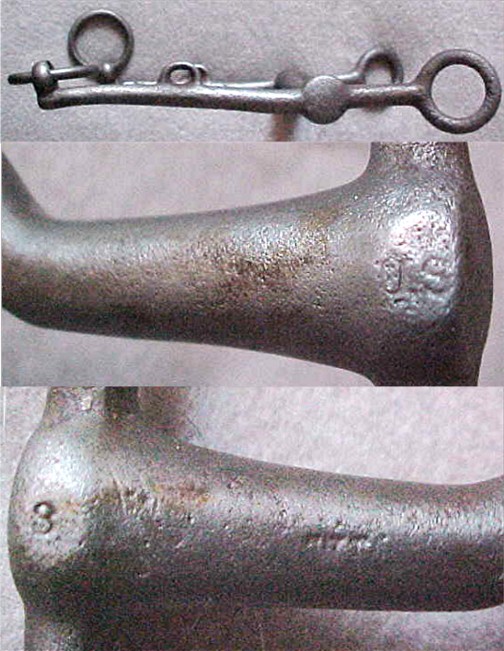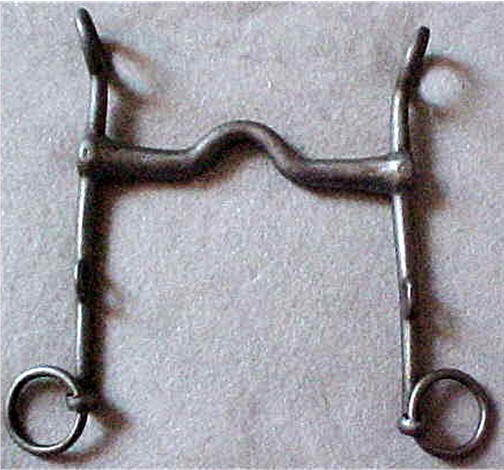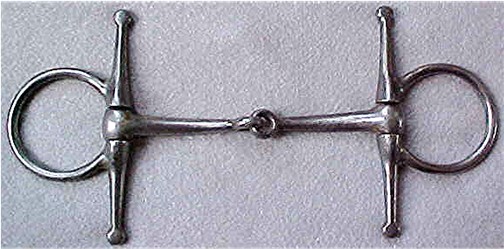| |
|
|
|
US ARMY 20TH
CENTURY BRIDLE BITS CURB, SNAFFLE:
As the US Army moved into the 20TH Century, a
new series of bridle bits were introduced in both the
cavalry and the artillery. Lighter in structure than
the bits of the 19TH Century and made of
corrosion resistant steel alloys, these bits served the
troopers well and saw historic service along the border
with Mexico, in the Philippine Islands, on the
battlefields of Europe in World War One and across the
globe during World War Two. Many of these bits are
still in active service in the inventory of such
ceremonial units as the famous Old Guard at Fort Myers,
Virginia which provides the mounted honor guards and
trace horses for ceremonies in Washington D.C. and at
Arlington National Cemetery.
|
|
MODEL 1909 CURB BIT: Developed as an
element of the Experimental Model 1906 Curb Bit and
Bridoon Bridle system, and eventually classified as the
Model 1909 Curb Bit, this bit was the last major design
change in cavalry bridle bits for the U.S. Army, and
remained in service through the end of World War Two.
Legibly marked US on one mouthpiece boss, and 3 on
the other, indicating the size, this bit is also marked
W.L on the mouthpiece just in from the left cheek
piece indicating this bit was manufactured under
contract for the army by White-Horse LeCompte
Manufacturing Company of New York. As with the
McClellan Saddles, with the increase in demand for
equipment with the entrance of the United States into
World War One, many of these bits were produced by
civilian contractors.
This bit is in very good condition, showing only minimal
signs of wear or aging, with a clean overall finish and
has survived in full form with both rein rings intact,
and with no misshaping and no damage. Overall, this is
a nice example. (1036) $50
 |
 |
 |
|
MODEL 1911 ARTILLERY SNAFFLE BIT: Ordered
in 1909, this M1911 Artillery Snaffle Bit ended the
universal use by the army of curb bits for draft
animals, a practice they had adhered to since the
1840s. Featuring a hinged mouth piece and full cheek
rings with a bar tangent to each ring, these bits were
deemed ample to control most draft animals in the traces
to pull the field pieces. Marked RIA for Rock Island
Arsenal, the place of manufacture, US and NS for
nickel steel, an alloy noted for its ability to resist
corrosion. This specimen is not date stamped 1911 as
is commonly found on these bits. The lack of a date
stamp is possibly indicative that this bit was
manufactured as part of the original order in the first
year of production, 1909, and it was not until the bit
was tested and accepted for general issue that the date
was applied. This same lack of dates on first year of
production specimens has been noted in the date stamping
of other equipment manufactured at the arsenals during
this period (i.e. M1906 and M1908 Cups). This bit is in
excellent condition, showing only minimal signs of wear
or aging and no corrosion, is in full form, and all of
the marks are legible and bright. (0102) $75
 |
 |
 |
|
|
|
|
|
|
|
|
|
|
|
|
|
|
|
|
|
|
|
|
|
|

